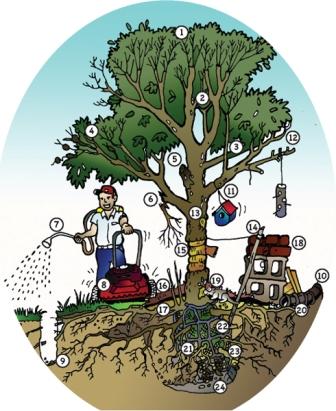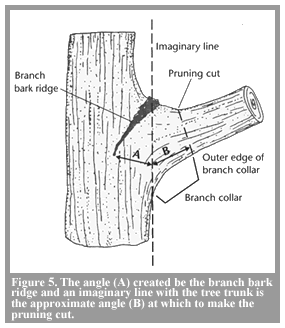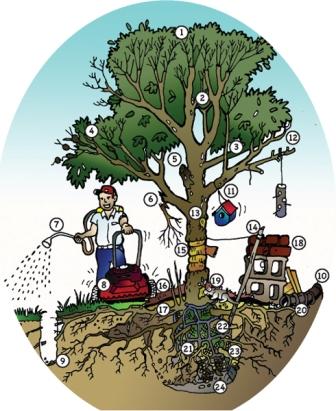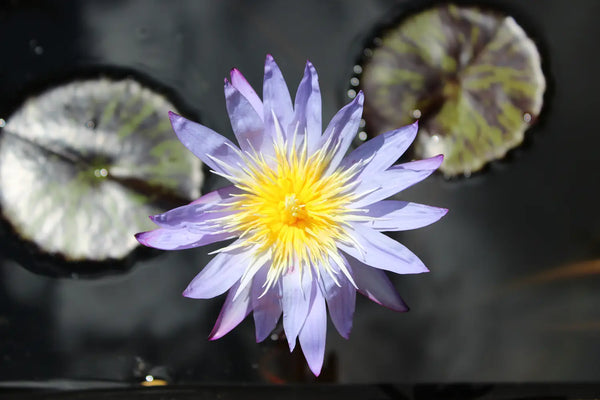
If you are a homeowner, there is a great chance that you have trees in your yard or have even planted a few in your day. It wasn’t until attending a Master Gardener class focusing on tree health that I quickly realized how many harmful activities I have continuously subjected my trees to. Looking around my neighborhood, it was apparent many of my neighbors are engaging in these same destructive activities as well.
An informative article from the Virginia Tech University titled, “How to Kill a Tree”, discusses 24 destructive activities that are potentially lethal to trees. It states that few residential trees actually die from “old age”. Most often, mechanical damage and improper tree care are to blame. Few of these activities alone would kill a tree, but multiple problems will stress, and eventually, could kill it.
Harmful Activity #1: “Top” tree to encourage water sprouts. Instead: Do not top the trees. Tree heights can be lowered by proper crown reduction that doesn’t encourage watersprouts.
Harmful Activity #2: Leave codominant leaders to encourage “V” growth and splitting during storms and wind. Instead: When a tree is young, choose one or the other of the competing upright branches to the main branch and the cut the other off.
Harmful Activity #3: Leave crossing branches to rub and cause bark wounds. Instead: Remove branches that cross and rub in order to prevent bark wounds.
Harmful Activity #4: Ignore insect or disease damage. Instead: Monitor for insects and diseases and treat promptly if found.
Harmful Activity #5: Coat pruning cuts with paint or sealer to slow healing. Instead: Do not use anything to cover

pruning cuts or wounds. Trees seal their own wounds.
Harmful Activity #6: Leave broken branches unpruned to invite pests. Instead: Cut broken branches off at the branch bark collar. (See Illustration, right)
Harmful Activity #7: Spray herbicides over tree root area to weaken the tree. Instead: Spray the lawn with herbicides that won’t harm the trees.
Harmful Activity #8: Damage roots and trunk with lawn equipment. Instead: Mulch around the tree to avoid hitting the tree trunk with lawn equipment and to protect surface roots.
Harmful Activity #9: Cut through roots when digging trenches. Instead: Dig around roots whenever possible. If unavoidable, make a clean pruning cut on the tree side of the root.
Harmful Activity #10: Plant the tree close to the house or other obstacle to reduce adequate growing space. Instead: Know the mature height and spread of the tree and space accordingly.
Harmful Activity #11: Nail or attach items to the tree to damage the bark and girdle branches. Instead: Insert a nail or screw into your tree for a wire or line to be attached. The tree will seal around the small wound.
Harmful Activity #12: Prune randomly to leave branch “stubs”. Instead: Cut branches back to laterals so you don’t leave stubs that will eventually die back.
Harmful Activity #13: Prune flush cuts to reduce wound closure. Instead: Do not make flush cuts. Cut on the outside of the bark collar.
Harmful Activity #14: Leave tree staked until guy wire girdles tree trunk. Instead: Stakes generally are not needed on small residential trees, but if needed, remove them after one year to avoid damage.
Harmful Activity #15: Leave wrap on to constrict tree growth and rot bark. Instead: Do not wrap the trunk with anything except a wide wire cage only if animals are a problem.
Harmful Activity #16: Pile excessive mulch to encourage rodent damage and rot bark. Instead: Do not put mulch in contact with the trunk. Pile mulch only 2-3 inches over the roots.
Harmful Activity #17: Put non-porous black plastic under mulch. Instead: Do not put any type of fabric or plastic material under the mulch.
Harmful Activity #18: Stack items atop roots to cause soil compaction. Instead: Do not stack items atop the roots. It causes soil compaction.
Harmful Activity #19: Leave ball lacing on to girdle trunk. Instead: Take the ball roping off around the tree trunk. If the tree is in a container, remove it before planting.
Harmful Activity #20: Plant near a downspout to assure excessive moisture. Instead: Divert water away from the roots of trees that don’t like wet soil. When you do water, be sure to water deep to encourage deep root growth.
Harmful Activity #21: Leave wire basket in place to girdle roots. Instead: Remove the top horizontal round of wire from the basket. It is not necessary to remove the entire basket.
Harmful Activity #22: Leave treated or synthetic burlap on to prevent root growth. Instead: Remove the burlap, regardless of type, from atop the ball and down several inches on the ball side. It is not necessary to remove all the burlap.
Harmful Activity #23: Dig hole too narrow and overamend backfill to discourage proper root spread. Instead: Dig the hole at least twice as wide as the root system to encourage lateral root growth out of the root ball. Do not amend backfill for individual tree holes. Only amend if the entire planting area can be amended.
Harmful Activity #24: Dig hole too deep or fill with gravel to collect water and drown roots. Instead: Dig your hole only as deep as the root system and do not put gravel in the bottom of the planting hole unless you install a drain to actively pull extra water away.
References:


